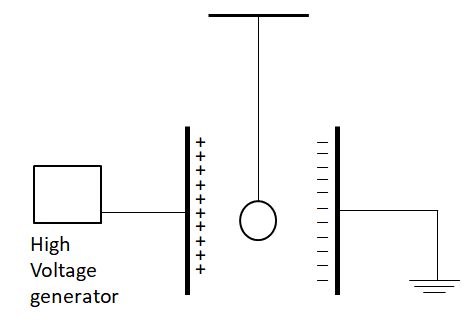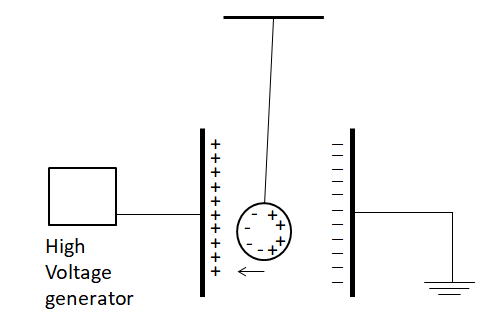
If a table tennis ball is covered by a conducting paint and is suspended by a silk thread to hang in between two plates one out of which is earthed and other is connected to high voltage generator, then the ball will
A. Swing forward and backward hitting each plate in turn
B. Hang without moving
C. Attracted to earthed plate and stays there
D. Attracted towards high voltage plate and stays there
Answer
479.4k+ views
Hint: Concept of induction is necessary to solve this problem. Knowledge of polarization of charge and how charge transfer takes place is required too. Knowing electrical induction is helpful too. Due to the charge induction process, the tennis ball will initially move towards the positive plate as the positive plate will attract greatly. Upon touching the plate, the tennis ball will gain positive charge and then the ball will move towards the grounded plate, having negative charge due to the induction process again. Upon touching the grounded plate, the positive charge will be grounded and gain negative charge due to induction as well. Hence, the ball will swing back and forth hitting each plate.
Complete step-by-step answer:
Let’s make a diagram of the setup to understand the process:

The grounded plate will have negative charge on it due to mutual induction. Due to the high positive charge in the plate connected to the high voltage generator, a corresponding negative charge will be induced on the ball suspended. That is, there will be a polarization of charge in the neutral table tennis ball, into equal amounts of negative and positive charge towards the opposite plates.
The below image shows the polarization of charge and how the ball gets attracted towards the positively charged plate.

Due to this attraction, the conducting ball will go and hit the positively charged plate. Due to physically coming in contact with the positively charged plate, the conducting ball gains positive charge.
Now, since both the plate and the ball are positively charged, they repel each other and further an attractive force pulls the now positively charged ball towards the negatively charged plate. Hence, the conducting ball goes and hits the negatively charged plate, grounding all of its positive charge and then gaining the negative charge of the plate which was produced due to induction. The plate again gets induced with negative charge as soon as the conducting ball is no longer in contact and hence, the repulsion also occurs between the plate and the conducting ball, forcing the ball to be forced towards the positively charged plate, towards which it is attracted as well now.
Again, due to induction, the conducting ball moves towards the positively charged plate as it happens initially and hence the loop continues on the conducting ball continually hitting the positively charged plate and then the other plate and back again.
Note: One may think, why doesn’t either of the plates have a change in charge, since the conducting ball is keeping on depositing charge from one plate to another. Here it is necessary to know that both the sources are continuously attached to the plates.
Hence, even though the conducting ball takes a little amount of charge from the positively charged plate, it is instantly compensated by the generator. The same goes for the grounded plate, the positive charge deposited is instantly grounded.
Complete step-by-step answer:
Let’s make a diagram of the setup to understand the process:

The grounded plate will have negative charge on it due to mutual induction. Due to the high positive charge in the plate connected to the high voltage generator, a corresponding negative charge will be induced on the ball suspended. That is, there will be a polarization of charge in the neutral table tennis ball, into equal amounts of negative and positive charge towards the opposite plates.
The below image shows the polarization of charge and how the ball gets attracted towards the positively charged plate.

Due to this attraction, the conducting ball will go and hit the positively charged plate. Due to physically coming in contact with the positively charged plate, the conducting ball gains positive charge.
Now, since both the plate and the ball are positively charged, they repel each other and further an attractive force pulls the now positively charged ball towards the negatively charged plate. Hence, the conducting ball goes and hits the negatively charged plate, grounding all of its positive charge and then gaining the negative charge of the plate which was produced due to induction. The plate again gets induced with negative charge as soon as the conducting ball is no longer in contact and hence, the repulsion also occurs between the plate and the conducting ball, forcing the ball to be forced towards the positively charged plate, towards which it is attracted as well now.
Again, due to induction, the conducting ball moves towards the positively charged plate as it happens initially and hence the loop continues on the conducting ball continually hitting the positively charged plate and then the other plate and back again.
Note: One may think, why doesn’t either of the plates have a change in charge, since the conducting ball is keeping on depositing charge from one plate to another. Here it is necessary to know that both the sources are continuously attached to the plates.
Hence, even though the conducting ball takes a little amount of charge from the positively charged plate, it is instantly compensated by the generator. The same goes for the grounded plate, the positive charge deposited is instantly grounded.
Recently Updated Pages
Master Class 12 Economics: Engaging Questions & Answers for Success

Master Class 12 Maths: Engaging Questions & Answers for Success

Master Class 12 Biology: Engaging Questions & Answers for Success

Master Class 12 Physics: Engaging Questions & Answers for Success

Master Class 12 Business Studies: Engaging Questions & Answers for Success

Master Class 12 English: Engaging Questions & Answers for Success

Trending doubts
Who is Mukesh What is his dream Why does it look like class 12 english CBSE

Who was RajKumar Shukla Why did he come to Lucknow class 12 english CBSE

The word Maasai is derived from the word Maa Maasai class 12 social science CBSE

What is the Full Form of PVC, PET, HDPE, LDPE, PP and PS ?

Which country did Danny Casey play for class 12 english CBSE

Differentiate between insitu conservation and exsitu class 12 biology CBSE




